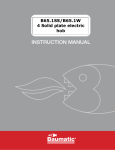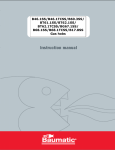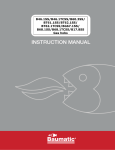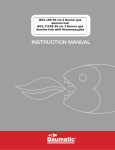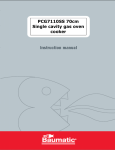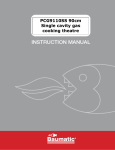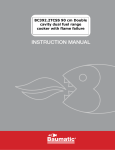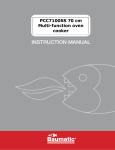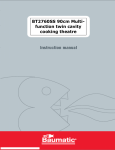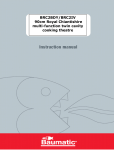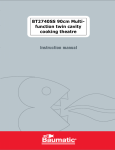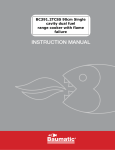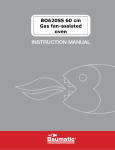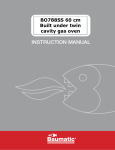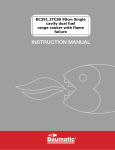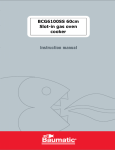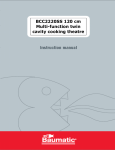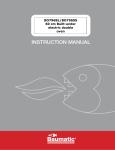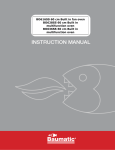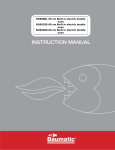Download Baumatic BT2745SS cooker
Transcript
BT2745SS 90 cm Twin cavity gas range cooker re User Manual for your Baumatic BT2745SS 90 cm Twin cavity gas range cooker NOTE: This User Instruction Manual contains important information, including safety & installation points, which will enable you to get the most out of your appliance. Please keep it in a safe place so that it is easily available for future reference; for you or any person not familiar with the operation of the appliance. DD 22/09/09 2 Contents Environmental note 4 Important safety information 5–9 Specifications Control panel Main oven control knob Secondary oven control knob Hob control knobs Minute minder control knob 9 – 12 11 11 11 12 12 Using your gas range cooker Before first use Switching the gas oven on (main and secondary oven) Switching the gas grill on (main and secondary oven) Using and assembling the rotisserie (secondary oven) Using the minute minder Cooking guidelines Warnings Base burner appliances 12 12 13 14 15 16 17 17 18 Using the hob top Pushbutton ignition Energy saving tips 19 - 20 19 20 Cleaning and maintenance Cleaning the hob burners Maintaining the cast iron pan stands Replacing the oven bulb Replacing the oven door for cleaning Removing the inner door glass for cleaning 21 - 24 22 22 23 23 - 24 24 Installation Positioning Gas connection Gas Safety (Installation and Use) Regulations Gas connection Gas adjustment (Conversion to LPG for the hob) Minimum flow adjustment for hob gas taps Gas adjustment (Conversion to LPG for the oven and grill) Minimum flow adjustment for the oven and grill burners Fitting a stability chain Electrical connection Connecting the mains supply cable Replacing the mains supply cable 25 25 27 28 29 30 31 32 33 34 35 36 36 My appliance isn’t working correctly 37 - 38 Contact details 39 - 18 - 13 - 16 - 18 - 37 - 26 - 28 - 31 - 33 - 37 3 Environmental note o The packaging materials that Baumatic uses are environmentally friendly and can be recycled. o Please discard all packaging material with due regard for the environment. 4 Important safety information Your safety is of the utmost importance to Baumatic. Please make sure that you read this instruction booklet before attempting to install or use the appliance. If you are unsure of any of the information contained in this booklet, please contact the Baumatic Advice Line. General Information o This appliance is designed for domestic household use and for the cooking of domestic foodstuffs. o IMPORTANT: The adjacent furniture and all materials used in the installation must be able to withstand a minimum temperature of 85°C above the ambient temperature of the room it is located in, whilst in use. o Certain types of vinyl or laminate kitchen furniture are particularly prone to heat damage or discolouration at temperatures below the guidelines given above. o Any damage caused by the appliance being installed in contravention of this temperature limit, or by placing adjacent cabinet materials closer than 20 mm to the appliance, will be the liability of the owner. o For use in leisure accommodation vehicles, please refer to the appropriate information given in the installation instructions for this appliance. o IMPORTANT: Baumatic Ltd. DO NOT recommend that this appliance is installed on any type of marine vessel. o The use of this appliance for any other purpose or in any other environment without the express agreement of Baumatic Ltd. will invalidate any warranty or liability claim. o Your new appliance is guaranteed against electrical or mechanical defects, subject to certain exclusions that are noted in Baumatic’s Conditions Of Guarantee. The foregoing does not affect your statutory rights. o Repairs may only be carried out by Baumatic service engineers or their authorised service agent. 5 Warning and safety instructions o This appliance complies with all current European safety legislation. Baumatic do wish to emphasise that this compliance does not remove the fact that the appliance surfaces will become hot during use and retain heat after operation. Child Safety o Baumatic strongly recommend that babies and young children are prevented from being near to the appliance and not allowed to touch the appliance at any time. During and after use, all surfaces will become hot. o If it is necessary for younger family members to be in the kitchen, please ensure that they are kept under close supervision at all times. General Safety Make sure that you understand the controls before using the appliance. Check that all of the controls on the appliance are turned off after use. Always stand back when opening the oven door, this will allow heat to disperse. Take care when removing items from the oven, as the contents may be hot. Always keep the oven doors closed when the oven is not in use. Always follow the basic principles of food handling and hygiene; this will prevent the possibility of bacterial growth. Always keep ventilation slots clear of obstructions. Keep fingers away from the hinge areas when closing the door, otherwise you may trap them. Oven gloves should be used when placing food in the oven cavity and when removing it. Care should be taken to avoid direct contact with any of the elements in the appliance. o DO NOT LEAVE THE APPLIANCE UNATTENDED WHILST IN USE. 6 o Do not place heavy objects on the oven door or lean on the oven door when it is open, as this can cause damage to the oven door hinges. Nobody should be allowed to sit or stand on any part of the cooker. o Do not store chemicals, food stuffs, pressurised containers in or on the cooker or in cabinets immediately above or next to the cooker. o Do not heat up unopened food containers, as pressure can build up which may cause the container to burst. o Do not place flammable or plastic items on or near the hob burners, these types of materials should also not be placed in the oven or the compartment below the oven. o Do not leave heated oil or fat unattended, as this is a fire risk. You should not fill a deep fat frying pan more than one third full of fat or oil; you should also not use a lid. o Do not allow fat or oil to build up in the oven trays, grill pan or oven base. o Do not place pans or baking trays directly on the base of the oven cavity, or line it with aluminium foil. o Do not grill food containing fat without using the grill trivet. The grill trivet should never be covered with aluminium foil. o Do not place hot enamel parts in water, leave them to cool first. o Do not allow vinegar, coffee, milk, saltwater, lemon, tomato juice or any liquid with high sugar content to remain in contact with the enamel parts of the appliance. Spillages should be wiped up immediately. o Do not allow electrical fittings or cables to come into contact with areas on the appliance that get hot. o Do not use the appliance to heat the room it is located in or to dry clothing. No clothing should be placed over or near to the hob burners or oven door. o Do not install the appliance next to curtains or soft furnishings. 7 o Do not attempt to lift or move cooking appliances by using the oven door or handle, as this may cause damage to the appliance or result in injury to the person lifting the appliance. Cleaning o Cleaning of the oven should be carried out on a regular basis. o Great care should be taken whilst using this appliance and when following the cleaning procedure. o IMPORTANT: The appliance must be disconnected from the mains before following the cleaning procedure. o IMPORTANT: Care must be taken when cleaning between the door glasses, and inside the inner frame as some of the edges maybe sharp due to the manufacturing process. Installation This appliance must be correctly installed by a suitably qualified person, strictly in accordance with the manufacturer’s instructions. Please see the specific section of this booklet that refers to installation. o Baumatic Ltd. declines any responsibility for injury or damage, to person or property, as a result of improper use or installation of this appliance. o Heat, steam and moisture will be created during use of the appliance, take care to avoid injury and ensure that the room is adequately ventilated. If the appliance is going to be used for prolonged periods of time, then additional ventilation may be required. o Please consult with your qualified installer if you are in any doubt about the amount of ventilation that you will require. Declaration of conformity This appliance complies with the following European Directives: -73/23/EEC regarding “low voltage” -89/336/EEC regarding “electromagnetic disturbances” -90/396/EEC regarding “gas appliances” -89/109/EEC regarding “materials in contact with food”. 8 o The above directives comply with 93/68/EEC regarding CE marking. o The manufacturer declares that the oven is built using certified materials and requires the appliance to be installed in accordance with the standards currently in force. This appliance must be used by a trained person for domestic purposes only. Specifications Product dimensions: Height: Width: Depth: 870-920 mm 895 mm 600 mm Product specifications: o o o o o 5 burner gas hob: 1 x 3.60 kW wok burner 1 x 3.00 kW rapid burner 2 x 1.75 kW semi-rapid burners 1 x 1.00 kW auxiliary burner o Pushbutton ignition o Heavy duty cast iron pan stands o o o o o Minute minder Cooling fan Flame failure safety device (oven and grill only) Double-glazed removable doors Adjustable feet 9 o o o o Left oven: Gas oven with grill 2 functions Oven capacity: 65 litres Storage compartment capacity: 18 litres o o o o Right oven: Gas oven with grill and rotisserie 2 functions Oven capacity: 37 litres Storage compartment capacity: 10 litres Standard accessories: o o o o o o 2 x Enamelled baking trays with handle 3 x Safety shelves 2 x Trivets LPG conversion jets Rotisserie skewer with removable handle and rack Wok stand Optional extras: o BPS2 Pizza stone o BTGRID Double-sided griddle plate Electrical details Rated Voltage: Supply Connection: Fuse Rating: Mains Supply Lead: 230 Vac 50 Hz 13 A (double pole switched fused outlet with 3mm contact gap) 3 amp 3 x 0.75 mm² Gas details Gas Connection Type: Gas Type (Natural Gas): Gas Type (LPG): 1/2” BSP 20 mbar See tables on page 30 and 32 for this information. For future reference please record the following information which can be found on the rating plate and the date of purchase which can be found on your sales invoice. The rating plate for your oven can be located by opening the door of the storage compartment. 10 Model Number ………………………………. Serial Number ………………………………. Date of Purchase ………………………………. Control Panel Main oven control knob o Use this control knob to light and set the temperature of the main oven. It should also be used to light the grill in the main oven. Secondary oven control knob o Use this control knob to light and set the temperature of the secondary oven. It should also be used to light the grill in the secondary oven. 11 Hob control knobs o Use these control knobs to light and control the hob burners. Minute minder control knob o Use this control knob to set the minute minder countdown. Using your gas range cooker Before first use o To remove any residue from the oven cavity that may have been left from the manufacturing process, you should light the gas oven and set it to its maximum temperature. You need to do this for both cavities. o IMPORTANT: You should not burn off both oven cavities simultaneously. o It is perfectly normal for a smell to be produced during this process. o You should make sure that any windows in the room are left open during this process. o It is advisable for you not to remain in the room whilst the burning off process is taking place. o You should leave each oven on maximum setting for 30 – 40 minutes. 12 o After both cavities have cooled, they should then be cleaned with warm soapy water, using either a sponge or soft cloth. No abrasive cleaners should be used. o Outer parts of the oven should be cleaned with warm soapy water, using either a sponge or soft cloth. No abrasive cleaners should be used. o We would recommend that an appropriate stainless steel cleaner and polish is regularly used on the stainless steel surfaces of this appliance. Switching the gas oven on (main and secondary oven) The oven cavities have pushbutton ignition, to light either one of them you should do the following:o Open the door to the cavity that you want to light. o Push the main or secondary oven control knob down slightly and then turn it anticlockwise to the word Max. o Whilst it is pointed to the word Max., fully push down the control knob and press the ignition button. o The gas oven should light within 15 seconds. o IMPORTANT: When you are certain that the oven burner is fully lit, release the control knob and ignition button, then close the oven door. Turn the control knob clockwise until it reaches the temperature that you desire. o DO NOT turn the control knob past the 130°C position, otherwise the burner may go out. o If the gas oven does not light within 15 seconds, then release the control knob. IMPORTANT: YOU MUST TURN THE CONTROL KNOB BACK TO ITS ORIGINAL POSITION; OTHERWISE GAS WILL CONTINUE TO BE RELEASED. o Wait for 1 minute, before repeating the ignition procedure again. When lighting your oven for the first time, it may take several times until the electric ignition operates. This is due to there being air in the gas pipe. 13 Switching the gas grill on (main and secondary oven) The grill in both cavities have pushbutton you should do the following:- ignition, to light the grill o Open the door of the main or secondary oven and fit the grill deflector to the front of the appliance. You should then close the oven door until it rests against the grill deflector. o Push the main or secondary oven control knob down slightly and then turn it anticlockwise to the grill symbol (shown opposite) o Whilst it is pointed to the grill symbol, fully push down this control knob and press the ignition button. o The gas grill should light within 15 seconds. o IMPORTANT: When you are certain that the grill burner is fully lit, release the control knob and ignition button. o THE OVEN DOOR MUST BE LEFT OPEN AND RESTING AGAINST THE GRILL DEFLECTOR WHILST YOU ARE GRILLING. o If the gas grill does not light within 15 seconds, then release the control knob. IMPORTANT: YOU MUST TURN THE CONTROL KNOB BACK TO ITS ORIGINAL POSITION; OTHERWISE GAS WILL CONTINUE TO BE RELEASED. o Wait for 1 minute, before repeating the ignition procedure again. When lighting either one of the grills for the first time, it may take several times until the electric ignition operates. This is due to there being air in the gas pipe. o IMPORTANT: You should allow the oven to cool completely before attempting to remove the grill deflector. If you attempt to remove the grill deflector before the oven is cool, the deflector will be hot. 14 Using and assembling the rotisserie (secondary oven) o Place the food on the spit (L), making sure that it is placed centrally between the two forks (F). Otherwise excess strain will be placed on the motor (R). o Place one end of the spit (L) onto support (G) and put the opposite end into the hole of the motor (P). o Fill the enamelled baking tray with a little water and place this under the spit (L). o Fit the grill deflector (S) into position and leave the door half way open. o Light the gas grill (as described previously) and then press the rotisserie on/off button (pictured opposite). o To rotate the spit in the opposite direction, whilst wearing a protective oven glove, turn the rotation knob (A). 15 o Make sure that you press the rotisserie on/off button, and then turn the secondary oven control knob to 0 before attempting to remove the spit (L). Using the minute minder The minute minder can be used independently of either oven or grill for a time period of up to 60 minutes. o To set the timer, turn the knob fully clockwise until it stops and then turn it back anticlockwise to the required time. o The time period that has been set will expire when the control knob reaches zero, a brief audible signal will sound. IMPORTANT: If you have the oven or grill in use whilst the timer is counting down. When the countdown ends, the oven will continue to heat. You must turn off the oven/grill using the relevant control knob. The oven light o The oven light button (pictured opposite), switches the light bulb on and off. Press this button down to switch the light on, then press the same button again to switch the light off. Each cavity has an individual oven light button. o The oven light can be switched on, regardless of whether the oven/grill is in use. o The light button for the main oven is on the left hand side of the control panel. The light button for the secondary oven is on the right hand side of the control panel. 16 Cooking guidelines o Please refer to the information given on food packaging for guidance on cooking temperatures and times. Once familiar with the performance of your appliance, temperatures and times can be varied to suit personal preference. o Preheat the oven for at least 15 minutes, before placing food into the cavity. o Preheat the grill for 5 – 10 minutes, before placing food into the cavity. o Make sure that frozen foods are thoroughly thawed before cooking, unless the instructions on the food packaging advise that you can “cook from frozen”. o Before cooking, check that any unused accessories are removed from the oven. o Place cooking trays in the centre of the oven and leave gaps between the trays to allow air to circulate. o Try to open the door as little as possible to view the dishes. Warnings o Keep the oven door open when using the grill function and make sure that the grill deflector is fitted. o Do not use aluminium foil to cover the enamelled baking tray or heat items wrapped in aluminium foil under the grill. o You should also never line the base of your oven with aluminium foil. o During cooking, never place pans or cookware directly onto the bottom of your oven. They should always be placed on the shelves provided. o The grill becomes extremely hot during operation, avoid touching it inadvertently when handling the food which you are grilling. o IMPORTANT: Be careful when opening the door, to avoid contact with hot parts and steam. 17 o The enamelled baking tray handle should only be used to reposition the tray and NOT for removing it from the oven cavity. When removing the enamelled baking tray, you should ALWAYS use an oven glove. o The enamelled baking tray handle should not be left in position when the appliance is switched on. Base burner appliances IMPORTANT: Your appliance is a Continental style/base burner gas oven, please follow the guidance below, to achieve the best cooking results. o There are two different types of heating methods for gas ovens, traditional U.K. style and Continental style. o In U.K. style gas ovens, the hot air moves around the oven and the hottest part of the cavity is at the top. o In Continental style gas ovens, the heat source is underneath the base of the oven, which means that the hottest part of the cavity is at the bottom. o Your oven is a Continental style gas oven, which may require some adjustment in your cooking method, if you are used to a U.K. style gas oven. o We would recommend that you place the enamelled baking tray into the lowest shelf position. o This will deflect some of the fierce heat generated by the base burner away from the food that you are cooking. o This will allow food to cook all of the way through, without getting burnt on the base. o You may also need to make small adjustments to the cooking temperature and cooking times that you normally used previously. 18 Using the hob top The following symbols will appear on the control panel, next to each control knob: Black circle: gas off Large flame: maximum setting Small flame: minimum setting o The minimum setting is at the end of the anti-clockwise rotation of the control knob. o All operation positions must be selected between the maximum and minimum positions. o Never select a knob position between the maximum and off position. Pushbutton ignition To ignite a burner: o Press in the control knob of the burner that you wish to light and turn it anti-clockwise to the spark symbol which is just after the maximum position. o Whilst keeping the control knob depressed, press the ignition button and the burner will light. Keep the ignition button pressed down until the burner is fully lit. o In case of power failure, the burners can be lit by carefully using a match. 19 Energy saving tips BURNERS PANS Minimum Maximum Ø Ø Wok 220 mm 260 mm Rapid 180 mm 220 mm Semi-rapid 120 mm 200 mm Auxiliary 80 mm 160 mm o The diametre of the bottom of the pan should correspond to that of the burner. o The burner flame must never extend beyond the diametre of the pan. o Use flat bottomed pans only o When possible, keep a lid on the pan whilst cooking. o Cook vegetables with as little water as possible, to reduce cooking times. IMPORTANT: Always place pans centrally over the hob burners and position them so that the handles cannot get accidentally caught or knocked off. You should also make sure that the handle is not over one of the other hob burner flames. 20 Cleaning and maintenance Cleaning operations must only be carried out when the oven is cool. The appliance should be disconnected from your mains supply before commencing any cleaning process. o The oven should be thoroughly cleaned before it is operated for the first time and after each use. This will avoid residual food stuffs becoming baked on the oven cavity. After residues have been baked on several times, they are far more difficult to remove. o Never clean the oven surfaces by steam cleaning. o The oven cavity should only be cleaned with warm soapy water, using either a sponge or soft cloth. No abrasive cleaners should be used. o Any stains that may appear on the bottom of the oven will have originated from food splashes or spilt food, these splashes occur during the cooking process. These could possibly be a result of the food being cooked at an excessively high temperature or being placed in cookware that is too small. o You should select a cooking temperature and function that is appropriate for the food that you are cooking. You should also ensure that the food is placed in an adequately sized dish and that you use the enamelled baking tray where appropriate. o Outer parts of the oven should only be cleaned with warm soapy water, using either a sponge or soft cloth. No abrasive cleaners should be used. o If you use any form of oven cleaner on your appliance, then you must check with the manufacturer of the cleaner that it is suitable for use on your appliance. o Any damage that is caused to the appliance by a cleaning product will not be fixed by Baumatic free of charge, even if the appliance is within the guarantee period. 21 Cleaning the hob burners The hob burners should be cleaned once a week or more frequently if they get soiled. o Remove the hob burners by pulling them upwards and away from the hob top. o Soak them for about ten minutes in hot water and a little detergent. o After cleaning and washing them, wipe and dry them carefully. o Before placing the burners back on the hob top, make sure that the gas jet is not blocked. o IMPORTANT: Make sure that you reassemble the burners in the original way. Maintaining the cast iron pan stands o IMPORTANT: Make sure that the hob surface and pan stands have cooled before you attempt to touch them. o Wipe the pan stands over with a soft, damp cloth that has been put into warm soapy water. The cloth should be wrung out after being taken out of the soapy water. o Using a paper towel, thoroughly dry the pan stands. o To maintain the appearance of the cast iron pan stands, we would recommend that you rub a small amount of olive oil into the pan stands. After you have finished cleaning them. 22 Replacing the oven bulb IMPORTANT: The oven must be disconnected from your mains supply before you attempt to either remove or replace the oven bulb. o Remove all oven shelves, and the enamelled baking tray. o Unscrew the lamp cover. o Unscrew the bulb and remove it from its holder. o Replace the bulb with a 25 W/300°C, screw type pigmy. o Do not use any other type of bulb. o Screw the lamp cover back into its original position. Removing the oven door for cleaning o Open the oven door fully. o The hinges (A) are provided with two movable hooks (B). o Rotate the hooks into the slot (C). o You should grip the sides of the door at the centre and then incline it slightly towards the oven cavity and then pull it gently away from the oven cavity. 23 o IMPORTANT: You should make sure that the door is supported at all times and that you place the door on some padded material whilst cleaning it. o The oven door and door glass should only be cleaned using a damp cloth and a small amount of detergent. The cloth MUST NOT have come into contact with any form of cleaning product or chemical previously. o Replace the oven door by introducing the hinges back into their relevant slots. Before closing the doors DO NOT FORGET TO RESET THE MOVABLE HOOKS. o DO NOT attempt to move the hooks whilst the door is not attached to the oven, as the hinges are under high spring tension and injury may result. Removing the inner door glass for cleaning o Do not use any abrasive cleaner that could cause damage. o Remember that if the surface of the glass panel becomes scratched, this could lead to a dangerous failure. o To facilitate cleaning, the door glass can be lifted out after removing the fixing screws and turning the metal stoppers that hold the glass in position. o IMPORTANT: Before removing the glass, make a note of which way round the door glass sits in the oven door. The glass must be put back into the door the same way. o The door glass should only be cleaned using a damp cloth and a small amount of detergent. The cloth MUST NOT have come into contact with any form of cleaning product or chemical previously. o When refitting, make sure that the glass is correctly seated in the door recess and the correct way round, before turning the metal stoppers back to their original position and fully tightening the fixing screws. 24 Installation The installation must be carried out by a suitably qualified person, in accordance with the current version of the following. o UK Regulations and Safety Standards or their European Norm Replacements. o Building Regulations (issued by the Department of the Environment). o Building Standards (issued by the Scottish Development Department). o IEE Wiring Regulations. o Electricity At Work Regulations. o Gas Safety (Installation and Use) (Amendment) Regulations. Positioning The adjacent furniture and all materials used in the installation must be able to withstand a minimum temperature of 85°C above the ambient temperature of the room it is located in, whilst in use. o Your appliance is heavy, so you should be careful when moving or positioning it. o Do not try to move the cooker by pulling on either the door, handle or control panel. o The cooker is designed to slot in between 600 mm deep cabinets, which are spaced approximately 940 mm apart. 25 o It can also be used as freestanding, with a cabinet to one side, in a corner setting or with its back to a wall. o IMPORTANT: It must not be situated with either side closer than 20 mm to a combustible wall or cupboard that is taller than the cooker. It should not be installed at the end of a run of cabinets, if there is a cabinet at immediate right angles to the cooker door. o The wall behind the cooker and 450 mm above and across the width of the cooker should be an incombustible material and preferably an easy clean surface, such as ceramic tiles. o Any overhanging surface or cooker hood should be at least 700 mm above the hob top. o Baumatic do not recommend that the cooker is positioned below wall cupboards, as the heat and steam from the appliance and what is being cooked, may damage the cupboard and its contents. o The cooker may be located in a kitchen, or a bedroom, but not in a room containing a bath or shower. The cooker must not be installed in a bedroom of less than 20m³ in size. o LPG models must not be installed in a room or internal space below ground level (e.g. in a basement). o The cooker is fitted with four legs that can be adjusted to match the height of your kitchen cabinets. o To assemble them it is necessary to raise the cooker and to screw the four legs into position, on each corner of the base of the appliance. o IMPORTANT: They must be screwed clockwise into position and not just slotted into the holes on each corner. 26 Gas connection This appliance must be installed by a competent person in accordance with the current versions of the following UK (United Kingdom) or ROI (Republic of Ireland) Regulations and Safety Standards or their European Norm Replacements. Important information o This cooker is supplied to run on natural gas only and cannot be used on any other type of gas without modification. o Conversion for use on LPG and other gases must only be undertaken by a qualified person. For information on the use of other gases, please contact the Baumatic Advice Line. o The cooker must be installed by a qualified person, in accordance with the current edition of the Gas Safety (Installation and Use) (Amendment) Regulations and the relevant building/I.E.E. Regulations. o Failure to install the appliance correctly could invalidate Baumatic’s guarantee and lead to prosecution under the regulations quoted above. o In the UK, GASSAFE registered installers are authorised to undertake the installation and service work, in compliance with the above regulations. Ventilation requirements o The room containing the cooker should have an air supply in accordance with the current edition of BS 5440: Part 2: o The room must have opening windows or equivalent; some rooms may also require a permanent vent. o If the room has a volume between 5 and 10m³, it will require an air vent of 50cm² (effective area). Unless it has a door which opens directly to the outside. o If the room has a volume of less than 5m³, it will require an air vent of 100cm² (effective area). o If there are any other fuel burning appliances in the same room the current edition of BS 5440: Part 2: should be consulted to determine air vent requirements. 27 o Ensure that the room containing the cooker is well ventilated, keep natural ventilation holes or install a mechanical ventilation device (mechanical cooker hood). o Prolonged intensive use of the appliance may call for additional ventilation, either by the opening of a window, or by increasing the level of the mechanical ventilation device (where present). o This cooker is not fitted with a device for discharging the products of combustion. Ensure that the ventilation rules and regulations are followed. o Excess steam from the oven, vents out at the top back edge of the cooker, so make sure that the walls behind and near the cooker are resistant to heat, steam and condensation. o Your cooker must stand on a flat surface so that when it is in position the hob is level. When in position check that the cooker is level by using a spirit level and adjust the 2 feet at the rear and the 2 feet at the front if necessary. o Remember that the quantity of air necessary for combustion must never be less than 2m³/h for each kW of power (see total power in kW on the appliance rating plate). Gas Safety (Installation and Use) Regulations o It is the law that all gas appliances are installed by competent persons in accordance with the current edition of the Gas Safety Installation and Use Regulations. o It is in your interest and that of safety to ensure compliance with the law. o In the UK, GASSAFE registered installers work to safe standards of practice. The cooker must also be installed in accordance with the current edition of BS 6172. Failure to install the cooker correctly could invalidate the warranty, liability claims and lead to prosecution. o IMPORTANT: It is a requirement for a stability chain to be fitted to the appliance. Please see page 34 for more detailed information on this. 28 Gas connection ALL INSTALLATION AND SERVICE WORK MUST BE CARRIED OUT BY A GASSAFE REGISTERED ENGINEER. o Prior to installation, ensure that the gas supply conditions (nature of the gas and gas pressure) and the adjustment conditions are compatible. The adjustment conditions for this appliance are stated on the rating plate which can be found on the back cover. o This appliance is not designed to be connected to a combustion product evacuation device. Particular attention should be given to the relevant requirements regarding ventilation. o Connection to the cooker should be made with an approved appliance flexible connection to BS 669. o If the cooker has been converted for use with LPG, then it should be connected to the gas supply using a bayonet type hose. The hose MUST be suitable for use with LPG gas. They are identifiable by a red band or stripe. o A hose length of 0.9m to 1.25m is recommended. The length of hose chosen should be such that when the cooker is in situ, the hose does not touch the floor. o Care should be taken to ensure that the temperature rise of areas at the rear of the cooker that are likely to come in contact with the flexible hose do not exceed 70°C. o Gas pressure may be checked on a semi-rapid hob burner. Remove the appropriate injector and attach a test nipple. Light the other burners and observe that the gas pressure complies with the gas standards in force. o This cooker can be connected to the supply both on the right and left hand side at the rear of the cooker. To reverse the position, remove the blanking plug and refit it to the opposite side to where the hose is being connected. o IMPORTANT: On completion carry out a gas tightness test. 29 Gas adjustment (Conversion to LPG for the hob) All work must be registered engineer. carried out by a GASSAFE IMPORTANT: Always isolate the cooker from the electricity supply before changing the injectors and/or adjusting the minimum flow of the burners. o Remove the pan-stands, burners and flame spreaders (A). o Unscrew the injector (B) and replace it with the stipulated injector for the new gas supply (see table below). Burner Auxiliary Semirapid Rapid Wok Gas Consumption* 28…30/37 Injector Marking (1/100 mm) 52 20 72 X 95 dm³/h 28…30/37 68 127 g/h 20 98 167 dm³/h 28…30/37 88 218 g/h 20 116 286 dm³/h 28…30/37 96 262 g/h 20 135 343 dm³/h Gas type Pressure (mbar) LPG (G30/31) Natural (G20) LPG (G30/31) Natural (G20) LPG (G30/31) Natural (G20) LPG (G30/31) Natural (G20) 73 g/h Power (kW) MAX MIN 1.00 0.30 1.75 0.44 3.00 0.75 3.60 1.50 30 * In reference conditions, gas temperature 15°C, atmospheric pressure 1013.25 mbar o Reassemble all the burners carefully; in particular you should make sure that the flame spreader is correctly placed on the burner. IMPORTANT: After changing the injectors YOU MUST follow the minimum flow adjustment section below. Minimum flow adjustment for hob gas taps All work must be registered engineer. carried out by a GASSAFE o Switch the burner on and set the knob at the minimum position. o Remove the knob from the tap and place a small bladed screwdriver to the outside the tap. o Unscrew the adjusting screw, in order to increase the gas flow or tighten the adjusting screw to decrease the gas flow. o The correct adjustment is obtained when the flame has a length of about 3 – 4 mm. o For butane/propane gas, the adjusting screw must be tightly screwed in. o Refit the control knob. o Make sure that the flame does not go out by quickly turning from maximum flow to minimum flow. If it does then remove the control knob and make further adjustments to the gas flow, testing it again once the adjustment has been made. o IMPORTANT: On completion carry out a gas tightness test. 31 Gas adjustment (Conversion to LPG for the oven and grill) All work must be carried out by a GASSAFE registered engineer. IMPORTANT: Always isolate the cooker from the electricity supply before changing the injectors and/or adjusting the minimum flow of the burners. o Free the burners from their fixing screws. o Unscrew the injectors and replace them with the stipulated injector for the new gas supply (see table below). Burner Main oven burner Main oven grill burner Secondary oven burner Secondary oven grill burner Gas type Pressure (mbar) Injector Marking (1/100 mm) Gas Consumption* LPG (G30/31) Natural (G20) LPG (G30/31) Natural (G20) LPG (G30/31) Natural (G20) LPG (G30/31) Natural (G20) 28…30/37 79 193 g/h 20 122 252 dm³/h 28…30/37 65 145 g/h 20 108 190 dm³/h 28…30/37 62 145 g/h 20 108 190 dm³/h 28…30/37 60 116 g/h 20 101 152 dm³/h Power (kW) MAX MIN 2.65 1.00 2.00 N/A 2.00 0.7 1.60 N/A 32 * In reference conditions, pressure 1013.25 mbar gas temperature 15°C, atmospheric IMPORTANT: You must change the oven and grill injectors. IMPORTANT: After changing the injectors YOU MUST follow the minimum flow adjustment section below. Minimum flow adjustment for the oven and grill burners All work must be registered engineer. carried out by a GASSAFE o Light the burner and set the knob at the minimum position. o Remove the knob from the tap and place a small bladed screwdriver to the outside the tap. o Unscrew the adjusting screw, in order to increase the gas flow or tighten the adjusting screw to decrease the gas flow. o The correct adjustment is obtained when the flame has a length of about 3 – 4 mm. o For butane/propane gas, the adjusting screw must be tightly screwed in. o Refit the control knob. o Make sure that the flame does not go out by quickly turning from maximum flow to minimum flow. If it does then remove the control knob and make further adjustments to the gas flow, testing it again once the adjustment has been made. o IMPORTANT: On completion carry out a gas tightness test. 33 Fitting a stability chain IMPORTANT: It is a legal requirement for your GASSAFE registered installer to fit a stability chain. The stability hook should be securely fixed to the fabric of the building, in an adjacent position to the safety chain at the rear of the appliance. The chain should be kept as short as is practical. 34 Electrical connection This appliance must be installed by a qualified person in accordance with the latest edition of the I.E.E. Regulations and in compliance with Baumatic’s instructions. WARNING: THIS APPLIANCE MUST BE EARTHED. o Before connecting the appliance, make sure that the supply voltage marked on the rating plate corresponds with your mains supply voltage. o This appliance should be wired into a 13 A double pole switched fused spur outlet, having 3 mm contact separation and the fuse rating reduced to 3 amps. This should be placed in an easily accessible position adjacent to the appliance, preferably above worktop level. An outlet can then be located at the rear of the appliance for connection. o Care must be taken to ensure that the temperature of the mains supply cable does not exceed 50°C. o If the mains supply cable is damaged, then it must be replaced by an appropriate replacement. o Cable type: H05 RRF 3 core x 0.75 mm³ 35 Connecting the mains supply cable IMPORTANT The wires in the mains lead are coloured in accordance with the following code: GREEN AND YELLOW BLUE BROWN EARTH NEUTRAL LIVE o Open the mains terminal block cover as shown, unscrew the cable clamp (A) and unscrew (not fully) the screws in the mains terminal block (L, N, E) which secure the three wires of the mains cable. o Fit the cable and refit the cable clamp (A). o Allow sufficient cable length for the cooker to be pulled out for cleaning, but do not let it hang closer than 50mm to the floor. o The cable can be looped if necessary, but make sure that is not kinked or trapped when the cooker is in position. Replacing the mains supply cable If the mains supply cable is damaged, then it must be replaced by an appropriate replacement. The mains supply cable should be replaced in accordance with the following instructions: o Switch the appliance off at the control switch. o Open the box of the supply board. o Unscrew the clamp (A) fixing the cable. o Replace the cable with one of the same length and in accordance with the specification given above. o The “green-yellow” earth wire must be connected to the terminal . It must be about 10 mm longer than the live and marked neutral wires. 36 o The “blue” neutral wire must be connected to the terminal marked with letter (N) - the live wire must be connected to the terminal marked with letter (L). My appliance isn’t working correctly The gas oven burner or grill burner do not light. * Check that the oven is switched on at your mains supply. * Check that the fuse in the spur outlet doesn’t need replacing. * Check that there is not a problem with your gas supply Food is cooking too quickly or too slowly. * Check that you are cooking at an appropriate temperature and shelf level. The oven is not cooking evenly. * Check that the oven is installed correctly. * Check that you are cooking at an appropriate temperature and shelf level. The oven light is not working. * Refer to page 23 and follow the “Replacing the oven bulb” section. I am getting condensation in my oven. * Steam and condensation is a natural by product of cooking any food with high water content, such as frozen food, chicken etc. * You may get condensation in the oven cavity and forming between the oven door glasses. This is not necessarily a sign that the oven is not working correctly. * Do not leave food in the oven to cool after it has been cooked and the oven has been switched off. * Use a covered container, where practical, when cooking to reduce the amount of condensation that forms. 37 IMPORTANT: If your appliance appears not to be operating correctly, then you should disconnect it from your mains supply and then contact Baumatic Customer Care on telephone number (0118) 933 6911. DO NOT ATTEMPT TO REPAIR THE APPLIANCE YOURSELF. Please note that if an engineer is asked to attend whilst the product is under guarantee and finds that the problem is not the result of an appliance fault, then you may be liable for the cost of the call out charge. The appliance must be accessible for the engineer to perform any necessary repair. If your appliance is installed in such a way that an engineer is concerned that damage will be caused to the appliance or your kitchen, then he will not complete a repair. This includes situations where appliances have been tiled in, sealed in with sealant, have wooden obstructions placed in front of the appliance, like plinths. Or any installation other than the one specified by Baumatic Ltd. has been completed. Please refer to the conditions of guarantee that appear on the warranty card that you receive with the appliance. IMPORTANT: Baumatic Ltd. operates a policy of continuous improvement and reserves the right to adjust and modify its products without prior notification. 38 United Kingdom Baumatic Ltd., Baumatic Buildings, 6 Bennet Road, Reading, Berkshire RG2 0QX United Kingdom Czech Republic Baumatic CR spol s.r.o. Průmyslová zóna Sever 696 460 11 Liberec 11 Czech Republic Sales Telephone (0118) 933 6900 Sales Fax (0118) 931 0035 Customer Care Telephone (0118) 933 6911 Customer Care Fax (0118) 986 9124 Spares Telephone (01235) 437244 Advice Line Telephone (0118) 933 6933 www.baumatic.cz E-mail: [email protected] [email protected] [email protected] [email protected] Website: www.baumatic.co.uk Republic of Ireland 01- 6266 798 +420 483 577 200 Slovakia Baumatic Slovakia, s.r.o. Galvániho 7/D Slovakia +421 255 640 618 Germany Baumatic Gmbh Lilienthalstrasse 1 320 52 Herford Deutschland +49 5221 694 99-0 www.baumatic.de Italy Baumatic Italia S.R.L. Via Caltana 129 Campodarsego (Padova), 35011 Italia +3904 9920 2297 www.baumatic.it Holland Baumatic Benelux B.V. Grindzuigerstraat 22 1333 MS ALMERE Nederland +3136 549 1555 www.baumatic.nl 39 40








































